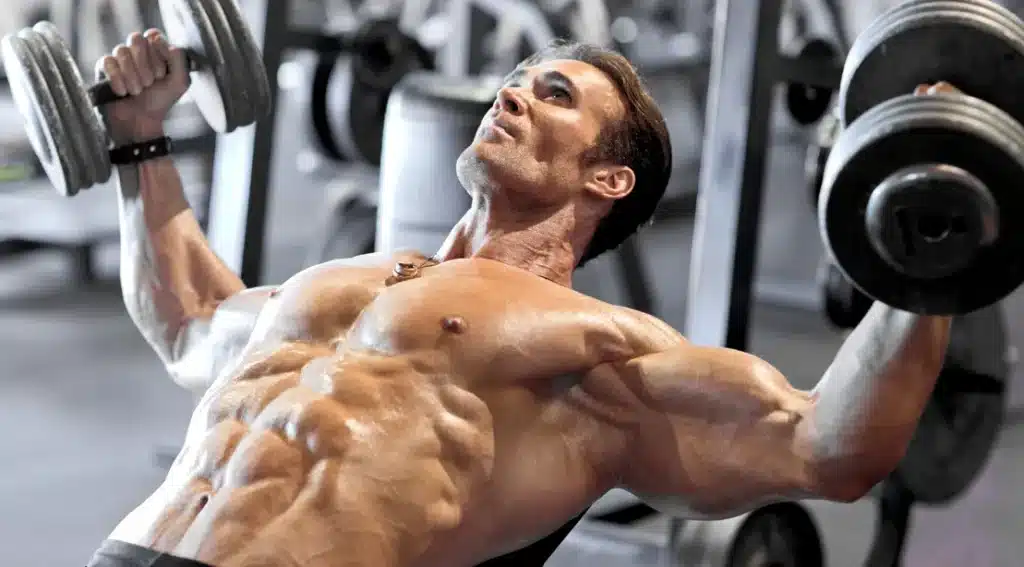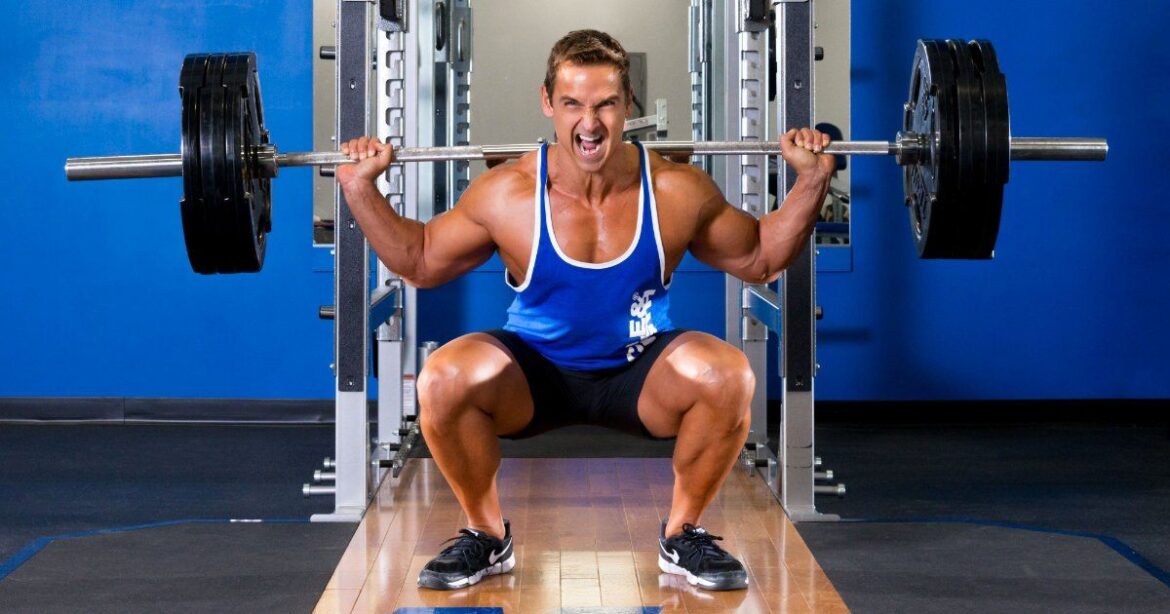Introduction
How To Train For Strength And Hypertrophy: Embarking on a journey to enhance physical strength and muscle growth is a pursuit that transcends the realms of mere exercise – it’s a deliberate and calculated approach to sculpting the body to its fullest potential. Training for both strength and hypertrophy (muscle growth) is a multifaceted endeavor that demands a blend of scientific understanding, disciplined commitment, and strategic execution. Whether you’re a seasoned athlete or a newcomer to the world of fitness, the pursuit of a well-balanced physique requires a comprehensive grasp of the principles that underlie effective strength training and hypertrophy training. This journey isn’t solely about lifting weights; it’s about crafting a lifestyle that revolves around incremental progress, intelligent workout design, and sound nutrition practices. Strength, the foundation of physical prowess, empowers individuals to carry out everyday tasks effortlessly while pushing their boundaries.
On the other hand, hypertrophy, the process of muscle enlargement, transforms the body’s composition, bolstering not only its aesthetics but also its functional capabilities. In this guide, we will delve into the art and science of training for both strength and hypertrophy. We’ll explore the physiological mechanisms that drive muscle growth and strength development, uncover the nuances of exercise selection and programming, and shed light on the dietary and recovery considerations that are integral to achieving optimal results. Whether your objective is to pack on muscle mass, lift heavier weights, or strike a harmonious balance between the two, this guide will equip you with the knowledge and tools to embark on a purposeful and effective training journey.
Remember, the pursuit of strength and hypertrophy is a dynamic process that demands patience, consistency, and an unwavering dedication to improvement. As we embark on this exploration of physical transformation, let’s set our sights on not just the destination, but the exhilarating path that will take us there – a path etched with determination, education, and a profound respect for the incredible potential of the human body. This journey is not a fleeting dalliance with dumbbells and barbells; it’s a profound immersion into the art of sculpting the body and fortifying the mind. Strength, the embodiment of power and resilience, translates to improved performance in sports, daily tasks, and overall functionality. Simultaneously, hypertrophy, the process of cultivating muscle mass, reshapes the body into a testament of hard work and dedication.

Can you train for both strength and hypertrophy?
Mixing hypertrophy and strength training into one comprehensive program is necessary, and can be done fairly easily if you understand how to monitor training volumes, recognize muscle soreness from general fatigue, and know what outcomes to aim for when training for hypertrophy vs strength.
Contrary to the notion that strength and hypertrophy are mutually exclusive, they actually share a considerable degree of overlap. This overlap lies in the physiological mechanisms responsible for muscle adaptation. While training for pure strength often focuses on lower rep ranges (1-5 reps) and higher intensities, it also results in some level of muscle growth due to the sheer demands placed on the muscle fibers during heavy lifts.
Conversely, training for hypertrophy also contributes to increased strength. As muscles grow in size, their cross-sectional area expands, providing a greater potential for force generation. Additionally, the adaptations induced by hypertrophy training, such as enhanced muscle glycogen storage and increased capillary density, can indirectly contribute to improvements in strength.
To effectively train for both strength and hypertrophy, many athletes and fitness enthusiasts adopt a hybrid training approach that combines elements of both goals. This approach involves periodization, where training cycles are structured to focus on different aspects of strength and hypertrophy in a coordinated manner.
During a strength-focused phase, individuals may emphasize lower rep ranges and higher weights to optimize neural adaptations and enhance their ability to lift heavier loads. Subsequently, a hypertrophy-focused phase could follow, incorporating higher rep ranges and increased volume to stimulate muscle growth. This cyclical approach allows for the synergistic development of both strength and size over time.
Does strength training improve hypertrophy?
Hypertrophy training and strength training are both great regimens for building muscle, but hypertrophy training is better for increasing muscle size, and strength training is best for increasing muscle strength. The right choice for you depends on your goals.
The relationship between strength training and hypertrophy (muscle growth) is a topic of significant interest within the fitness and bodybuilding communities. While these two goals may seem distinct, they are closely intertwined, and strength training does indeed play a crucial role in improving hypertrophy. Understanding this relationship can provide valuable insights into optimizing your training approach for both goals.
Strength training and hypertrophy share common physiological pathways that contribute to muscle growth. When you engage in strength training, particularly with heavy weights and low repetitions, you’re stimulating adaptations within the nervous system. This includes improved motor unit recruitment and the development of more efficient neural connections between your brain and muscles. These adaptations lead to an enhanced ability to generate force, which is a fundamental aspect of strength.
However, the process of lifting heavy weights also places significant mechanical stress on your muscle fibers. This stress triggers a cascade of events, including muscle damage and metabolic stress, that contribute to muscle protein synthesis and subsequent growth. While strength training primarily focuses on neural adaptations, it inevitably induces a degree of muscle hypertrophy due to these mechanical and metabolic factors.
Why is 8-12 reps best for hypertrophy?
It turns out that 8-12 reps is actually good advice. It sits in the Goldilocks Zone of reps and loading, it’s time efficient in that it can maximize the number of tough reps per set, it’s energy efficient in that it doesn’t require too many reps to stimulate hypertrophy, or involve loads that are unnecessarily heavy.
The 8-12 rep range is ideal for inducing metabolic stress and muscle damage, both of which are essential factors for stimulating muscle growth. When you perform sets in this rep range, your muscles are under tension for a longer period of time compared to lower rep ranges. This sustained tension leads to an accumulation of metabolites, such as lactic acid, which creates a metabolic environment conducive to muscle growth.
Additionally, the controlled and deliberate repetitions in this range allow for a greater focus on the eccentric (lowering) portion of the movement. Eccentric contractions are known to cause micro-tears in muscle fibers, which then repair and grow larger during the recovery process.
The 8-12 rep range provides a balance between the recruitment of different types of muscle fibers. Higher rep ranges predominantly recruit slow-twitch muscle fibers, which are more fatigue-resistant and better suited for endurance tasks. Lower rep ranges, on the other hand, focus on fast-twitch muscle fibers responsible for generating maximal force. The 8-12 rep range allows for substantial activation of both fiber types, promoting comprehensive muscle growth.
Time under tension (TUT) refers to the total duration that a muscle is under load during a set. In the 8-12 rep range, TUT is extended compared to lower rep ranges. This prolonged time under tension contributes to muscle fatigue, metabolic stress, and muscle damage, all of which are catalysts for hypertrophy.
How much rest for hypertrophy?
When the training goal is muscular hypertrophy, the combination of moderate-intensity sets with short rest intervals of 30-60 seconds might be most effective due to greater acute levels of growth hormone during such workouts.
Rest periods between sets influence multiple physiological processes during resistance training, including muscle recovery, energy system replenishment, and overall workout performance. Longer rest periods allow for greater recovery of phosphocreatine, a high-energy molecule used during short bursts of intense exercise, which is beneficial for lifting heavy weights and targeting maximum strength.
On the other hand, shorter rest periods can lead to metabolic stress and fatigue, promoting muscle damage and the release of anabolic hormones like growth hormone and testosterone – all of which contribute to hypertrophy.
The optimal rest period for hypertrophy depends on your specific goals and the training intensity you’re pursuing. While shorter rest periods (around 30-60 seconds) are often associated with hypertrophy-focused workouts, slightly longer rest periods (around 1-2 minutes) can also be effective.
For pure hypertrophy-focused training, shorter rest periods are generally preferred. These periods maintain an elevated metabolic environment, stimulate greater muscle fatigue, and encourage muscle growth through mechanisms like cell swelling and metabolic stress.
If your training incorporates heavy lifts or strength-focused exercises, slightly longer rest periods may be more suitable. This allows for sufficient recovery of your nervous system and phosphocreatine stores, enabling you to lift heavier weights with proper form and intensity.
Why are powerlifters so strong?
You’ll also be more likely to increase how much weight you can move. Therefore, intensity, which translates to the load on the bar and how hard your body has to work to lift it, is a big reason why powerlifters are stronger than bodybuilders.
Powerlifters devote countless hours to perfecting their lifting technique. Achieving optimal biomechanics during lifts allows them to utilize their body’s leverage to their advantage, minimizing energy wastage and maximizing the transfer of force from their muscles to the weights. Skillful technique enables powerlifters to efficiently lift heavier loads while minimizing the risk of injury.
While powerlifters prioritize strength, their training often leads to significant muscle growth as well. Muscles that are larger in cross-sectional area have the potential to generate more force. Powerlifters build muscle mass not only in the primary muscles involved in the squat, bench press, and deadlift but also in the supporting muscles that contribute to overall stability during the lifts.
Powerlifters adhere to specialized training protocols that focus on progressively overloading their muscles with heavy weights. Their training includes periodization, which involves cycling through different phases of intensity, volume, and recovery. This approach helps prevent plateaus and promotes continuous strength gains.
Who is stronger powerlifter or weightlifter?
Powerlifting is less technical than Olympic lifting and uses heavier weights. Since both types of lifting build strength, both types of lifters are stronger than typical weightlifters. Powerlifters are able to build a lot of size and body mass because of the heavy lifting and big muscle gains.
Powerlifters are known for their incredible ability to generate force through these compound movements. Their training often involves low repetitions and high weights, contributing to both neural adaptations and muscle growth. The sheer amount of weight lifted during powerlifting competitions is a testament to their raw strength and the physical demands they place on their bodies.
Weightlifting, on the other hand, consists of two lifts: the snatch and the clean and jerk. These movements require a combination of explosive power, speed, technique, and flexibility. Weightlifters lift heavy weights overhead with remarkable speed and precision, requiring a high level of coordination and neuromuscular control.
Weightlifters excel in producing rapid force during the explosive phases of their lifts. Their training emphasizes power development, speed, and technical mastery, often involving higher repetitions and lower weights compared to powerlifting. While the absolute weights lifted in weightlifting competitions might be lower than those in powerlifting, the dynamic nature of the lifts showcases the incredible power and coordination of weightlifters.
How many leg days per week?
Generally, it’s recommended to train your legs three times a week, with each workout lasting 15 to 20 minutes and targeting different parts of the legs in each routine. For instance, a good plan would be to work on calves one day, thighs the next and then hips during the final session.
When it comes to building a well-rounded and balanced physique, leg training is often considered a cornerstone of any fitness regimen. However, the question of how many leg days per week is optimal for achieving your goals remains a subject of debate among fitness enthusiasts and experts. Striking the right balance between muscle recovery, intensity, and overall training volume is crucial for maximizing gains while avoiding overtraining. In this article, we’ll delve into the factors that influence the frequency of leg training and provide guidance on how to determine the ideal number of leg days per week for you.
The number of leg days you should include in your weekly workout routine depends largely on your individual goals and current training level. Generally, beginners might start with fewer leg days to allow their muscles and joints to adapt to the new stress, while more advanced individuals might be able to handle higher frequencies due to increased recovery capacity.
The frequency of leg days must also consider recovery. Legs are large muscle groups that require ample time to repair and grow between sessions. Overtraining can lead to injury, fatigue, and hindered progress. Listen to your body and be aware of signs of overtraining, such as persistent muscle soreness, decreased performance, and disrupted sleep.
Which exercise increases testosterone the most?
Resistance training
Resistance exercises are proven by research to help increase short- and long-term T levels. Resistance training like weightlifting is the best type of exercise to boost testosterone in both the short and long term. It’s been found to be especially helpful for men.
High-Intensity Interval Training (HIIT) involves alternating between short bursts of intense exercise and periods of rest or low-intensity activity. HIIT has gained popularity for its efficiency in burning fat and improving cardiovascular fitness. Some studies suggest that HIIT may also lead to temporary spikes in testosterone levels post-exercise.
Engaging in heavy resistance training, characterized by lifting relatively heavy weights with lower repetitions, can stimulate testosterone release. The stress placed on muscles during heavy lifting can activate the body’s hormonal response, including increased testosterone production.
It’s important to note that while exercise can influence testosterone levels, adequate rest and recovery play an equally crucial role. Overtraining, inadequate sleep, and chronic stress can lead to a decrease in testosterone levels. Ensuring you’re getting enough sleep, managing stress, and allowing sufficient time for muscle recovery is essential for maintaining healthy testosterone levels.

Conclusion
Embarking on the dual journey of training for strength and hypertrophy unveils a profound connection between the mind and body, reshaping not only our physical forms but also our perceptions of what we’re capable of achieving. This expedition is one of dedication, strategy, and continual growth, encapsulating the essence of human potential and determination. The amalgamation of science-backed training methodologies, informed exercise selection, and mindful nutrition creates a harmonious convergence that propels us toward our goals. The pursuit of strength cultivates a body capable of extraordinary feats, while the quest for hypertrophy sculpts a canvas of muscle that reflects our commitment.
However, amidst the pursuit of physical transformation, it’s crucial to emphasize that patience and consistency are our steadfast companions. Overnight changes are elusive, and setbacks are inevitable, yet they are integral parts of this transformative journey. The true essence lies not only in the end results but in the unwavering dedication to self-improvement. Remember that every repetition, every session, and every nutritious meal contributes to the symphony of progress. Be kind to yourself during moments of challenge, and celebrate even the smallest victories. By comprehending the science, respecting the process, and acknowledging the personal nuances, you’re poised to embark on a path that not only enhances your physical prowess but also nurtures a resilient and tenacious spirit.
As the final curtain falls on this guide to training for strength and hypertrophy, let it be a prelude to a new chapter in your fitness journey. Armed with knowledge, empowered by dedication, and fueled by a burning desire for growth, you have the tools to orchestrate a transformation that extends far beyond the confines of the gym. This journey isn’t just about building muscle and strength; it’s about embracing the relentless pursuit of excellence in every facet of life. As we wrap up this comprehensive guide, it’s evident that the synergy between strength and hypertrophy transcends the weights and repetitions. It’s a holistic transformation that extends its roots into the very essence of our determination. The meticulous design of workouts, the careful selection of exercises, and the consideration of nutrition and recovery all contribute to this symphony of growth.

